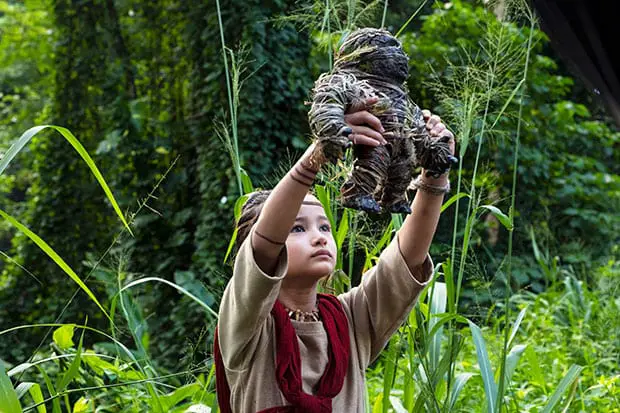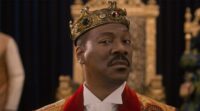The only truly human connection in Godzilla vs Kong exists between a child and a monster. This is not just a by-product of how Adam Wingard’s film is written but the only realistic means of conveying a film about human and natural destruction on a frankly abhorrent scale.
Mashing up the two most iconic monsters in cinematic history does not just have narrative precedence, going all the way back to Japan’s Toho Studios in the 1960s, but makes sense for fiscal reasons. Godzilla: King of the Monsters in 2019 presented Godzilla as a champion of the underworld, a demi-God ‘Titan’ represented as the slayer of Lovecraftian monstrosities dragged from the depths by human meddling. Kong: Skull Island crafted Kong as the protector of a lost paradise, a warrior detached from his tribe who beats back the encroaching reach of American imperialism in the Vietnam era. In both films, the so-called monsters were cast as forces of nature with nobility and conscience, often the victims themselves of human corruption and hubris.
In bringing these two heroic monstrosities together, Wingard’s film faces a contradiction. How do you make two sympathetic entities battle and convince the audience who to root for? Many viewers will already have their preferences on who they would wish to see reign supreme, depending on their attachment to either Godzilla or Kong, but Wingard’s film very quickly places both monsters less in the role of hero or villain but rather the manipulated ‘old gods’ of a new species.

Kong is no longer ruling supreme on Skull Island but rather contained in his own Truman Show-style domed construction, simulating his paradise while scientists from Monarch, the organisation tracking ‘Titan’ activity, study him and keep him secreted to, by their reasoning, prevent Godzilla finding and trying to kill him as part of an ancient recurring battle for supremacy of the Titan world. “There can’t be two Alpha Titans” states scientist Dr. Ilene Andrews (Rebecca Hall), channeling her inner Connor MacLeod. Godzilla, conversely, rises from his ocean depths to attack a base owned by the nefarious conglomerate Apex Industries, only for him to be recast in the media from saviour of humanity (as he was at the end of King of the Monsters) to monster terrorist. Both begin the film as an ‘Other’ separate from humankind.
What becomes swiftly apparent is how much both Godzilla and Kong represent both nature and the destructive power of a rapidly changing environment. Gojira, as he was known by superstitious Japanese believers (and was of course his name in Japanese from the original 1954 movie), was created thanks to atomic bomb tests in the Cold War hostility and terror of mutually assured destruction in the post-war climate; a literal entity fostered by nuclear power who rose up from the depths to attack the land. Kong was the exacerbated example of the primate, the savage, a giant version of a creature you might find docile in a zoo capable of climbing buildings, leaping from bound to bound—a forerunner of the Hulk as the beast hiding a tender beauty. In this case, Kong is the side of the natural world who protects rather than destroys.
Both of our central monsters in Godzilla vs Kong nevertheless represent equal aspects of the same conceptual idea: the defence of a tormented natural world against destructive human forces. Kong’s connection is with Jia (Kaylee Hottle), a young deaf girl who pretends to be one of the Skull Island natives and teaches Kong sign language to communicate with him. Kong’s sadness and anger at his captivity are tempered by Jia’s innocent kindness. This is the only relationship in Wingard’s film that means anything as it speaks to the relationship between youth and nature. Jia’s generation, as they become adults, will be facing the greatest crisis in the history of humanity with the effects of climate change and the consequences of the previous generations’ destruction of the natural world. None of the adults in Godzilla vs Kong approach the Titans with anything other than containment or pure ignorance, or exploitation.

As with many such films revolving around monstrous creations, the true villain is man and in this case particularly Walter Simmons (Demian Bichir), the billionaire behind Apex Industries, a nefarious organisation looking to exploit the power of the Titans in order to conquer them. Apex, named no doubt intentionally after the predator, is the culmination of man’s hubris against nature. Simmons believes he can harness the energy of Godzilla and his Titans and creates Mechagodzilla, a technological aberration, to challenge the natural world. Mechagodzilla is an abomination in the face of natural order, a suggestion of humanity’s future exploitation of artificial intelligence and the technological world working in contrast to the natural order, and it forces nature (Godzilla and Kong) to join the dichotomies in their own self to destroy him. We are never really meant to be on the side of either Godzilla or Kong. We are meant to be against the corruption and exploitation of our natural resources.
Jia is the singular character who understands this throughout the film. She listens to nature. She respects it. She understands there is no binary contrast between aspects of nature. “Godzilla, not enemy,” she tells Kong, encouraging them toward unity. She serves as Godzilla vs Kong’s hopeful challenge to the future, amidst the empty chaos and wanton destruction wrought by the Titans on naval fleets or across Hong Kong (which no doubt would have taken hundreds of thousands of innocent human lives). There is a suggestion these structures are falling not because of nature but because we have abused it, tried to bend it to our will, or refused to respect the awesome majesty of its power. Godzilla and Kong are not exactly the balm or cure, as Vera Farmiga’s character believed in the previous film King of the Monsters, but they do not have to be our undoing.
Godzilla vs Kong might ultimately be a simplistic blockbuster built on popcorn expectation, through a resolutely American gaze, but it does project an air of sorrow and melancholy at the fact these Titans, these forces of nature, are battling in the first place. It is a film searching for peace, and finds it only in the hope and belief, and empathy, of a child.



I felt this was a good movie that was hindered by the unfortunate reality that it had to be filmed mostly during a global pandemic. I thought that was very self-evident while watching the human portions of the movie, where characters are mostly interacting in small groups, rarely ever coming in contact with each other, and staged completely against what were obviously giant green screens. Not the movies fault, I think the director did the best he could with it.
However, the monster portions really delivered, and the movie delivered perfectly on the promise of “Kong vs Godzilla”. These parts of the movie were great, and probably the only parts I would want to rewatch again in the future. I was surprised that the movie mostly followed Kong and his journey, and Godzilla was placed more in the antagonist role for much of the movie. It made me really feel for Kong and root for him to “win” much more than I anticipated. Kong feels more relatable than Godzilla, and his connection with Jia was the strongest relationship in the movie, by far. So I ended up siding with him more than I expected I might.
The movie was a very fun time, it made the most of the unfortunate timing of it’s production, but ultimately suffered because of it. I loved the big battle scenes and scenes with the monsters, and I hope this series continues. There is a lot more fun to be had in this world as long as they continue to avoid the over-seriousness of the Godzilla(2014) movie. This is a good direction for the series, and I hope to see more Mothra and look forward to many more monsterverse movies to come.